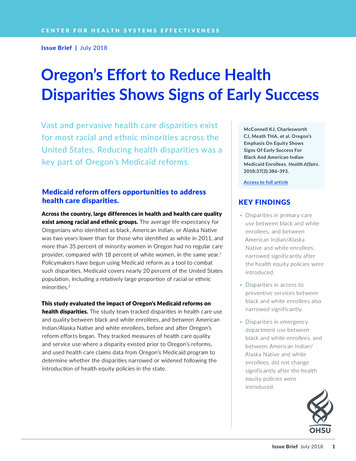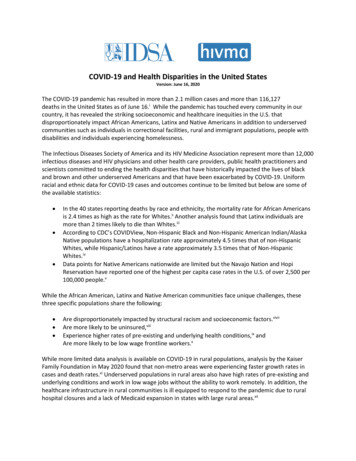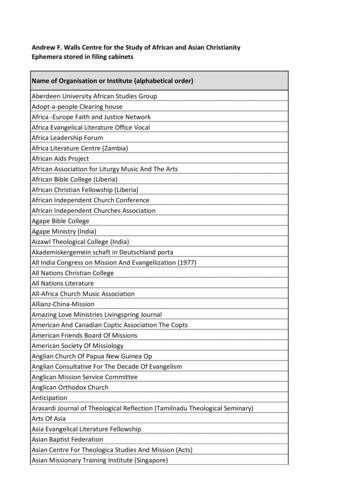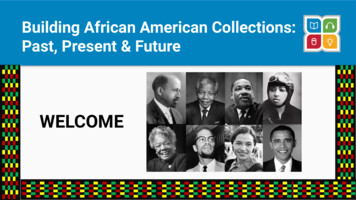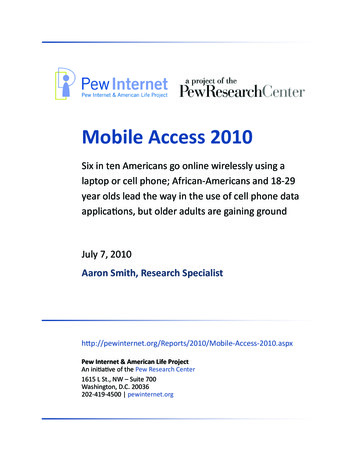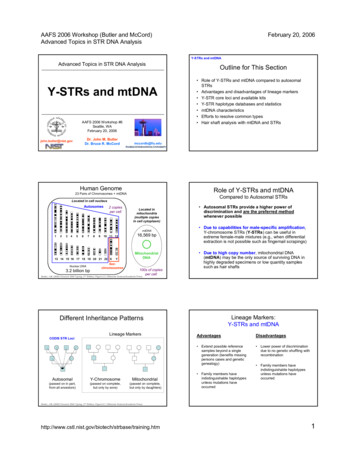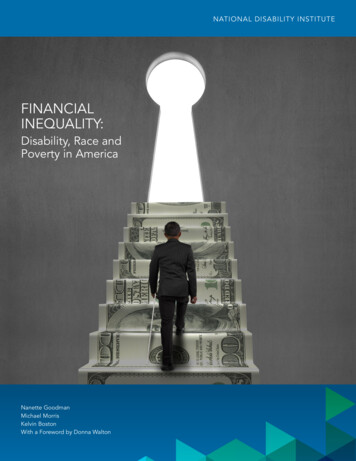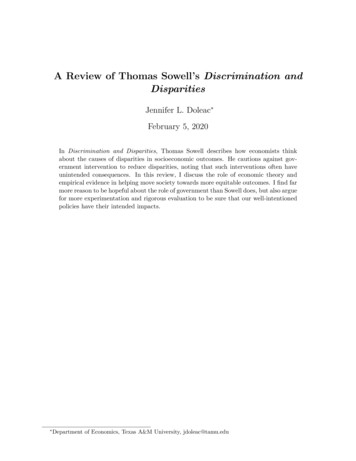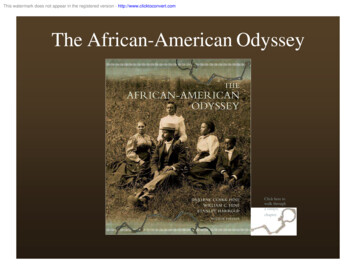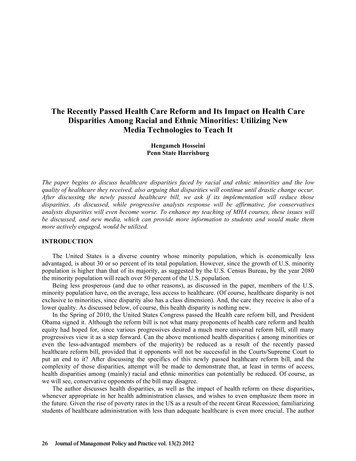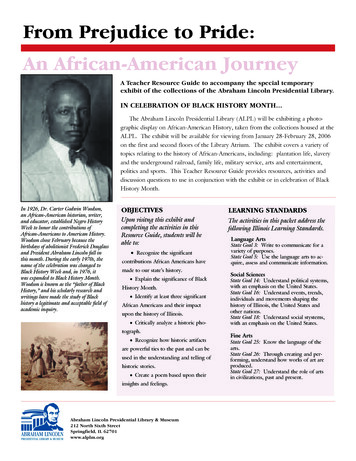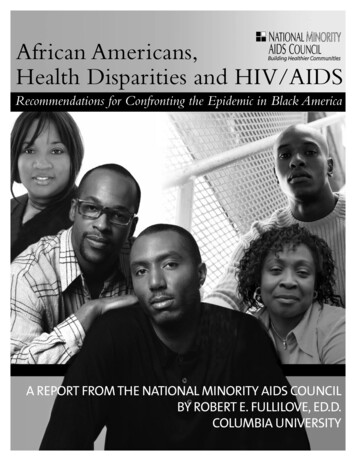
Transcription
AFRICAN AMERICANS, HEALTHDISPARITIES AND HIV/AIDSAfrican Americans,Health Disparities and HIV/AIDSRecommendations for Confronting theEpidemic in Black AmericaRobert E. Fullilove, Ed.D.Associate Dean for Community andRecommendations forConfronting the Epidemic in Black AmericaMinority Affairs &Professor of Clinical SociomedicalSciencesMailman School of Public HealthColumbia UniversityDraft: October 6, 2006A REPORT FROM THE NATIONAL MINORITY AIDS COUNCILBY ROBERT E. FULLILOVE, ED.D.COLUMBIA UNIVERSITY
November 2006National Minority AIDS Council
This report was written on behalf of the NationalMinority AIDS Council (NMAC), the premierREPORT ADVISORY PANELAdaora Adimora, M.D., M.P.H.Richard Payne, M.D.Associate Professor of Medicine, University ofProfessor of Medicine, Director, DukeNorth CarolinaInstitute on Care at the End of Lifeexperts from a cross-section of disciplines — public health,A. Cornelius BakerNational Policy Advisory, National Black GayBeny J. Primm, M.D.medicine, HIV/AIDS advocacy, prisons and national AfricanAmerican leadership organizations — listed on this page.Men’s Advocacy Coalitionnational organization dedicated to developingleadership within communities of color to address the challengesof HIV/AIDS. It was reviewed by the panel of leadingCarl BeanBishop, Unity Fellowship ChurchFounder and Executive Director, AddictionResearch and Treatment CorporationChair Emeritus, NMACSheryl Lee RalphThe following organizations have endorsed AfricanJulian BondActress/Broadway Legend,Americans, Health Disparities and HIV/AIDS:Chairman, National Association for theNMAC SpokespersonRecommendations for Confronting the EpidemicAdvancement of Colored People (NAACP)in Black America:The Honorable Donna M. ChristensenDavid Resnik, J.D., Ph.D.Bioethicist, National Institute ofAIDS Housing of Washington, Seattle, WADelegate to Congress (D-U.S.Virgin Islands)The AIDS Institute, Washington, DCThe Honorable John Conyers, Jr.AIDS Project Los Angeles, Los Angeles, CAU.S. Representative (D-MI)AIDSNET, Bethlehem, PAMarian Wright EdelmanDean, Mailman School of Public Health,President, Children’s Defense FundColumbia UniversityAsian and Pacific Islander Health Forum, Washington, DCBrotherhood, Incorporated, New Orleans, LAComunity Health Outreach Workers (CHOW),Detroit, MIDebra Fraser-HowzePresident and CEONational Black Leadership Commission on AIDSSandra L. Gadson, M.D.Community HIV/AIDS Mobilization ProjectImmediate Past President,(CHAMP), New York, NYNational Medical AssociationCommunity Enrichment Organization, Tarboro, NCJoseph Gathe, Jr., M.D., F.A.C.P.Florida Department of Health, Bureau of HIV/AIDS,Clinical Instructor, Baylor College of MedicineTallahassee, FloridaElizabeth GaynesHarm Reduction Coalition, New York, NY andExecutive Director,The Osborne AssociationOakland, CABruce S. GordonHealth Education Resource Organization, Inc. (HERO),President, National Association for theBaltimore, MDAdvancement of Colored People (NAACP)Lambda Legal, New York, NYThe Honorable Barbara LeeLos Angeles Gay & Lesbian Center, Los Angeles, CAThe National Black Alcoholism and Addictions Council,Inc., Orlando, FLU.S. Representative (D-CA)York, NYNational Youth Advocacy Coalition, Washington, DCProject GRACE/Community Enrichment Organization,Tarboro, NCSaint Joseph’s Mercy Care Services, Inc., Atlanta, GATotal Health Awareness Team, Rockford, ILNational Institutes of HealthAllan Rosenfield, M.D.David Satcher, M.D., Ph.D.Director, Center of Excellence on HealthDisparities, Morehouse School of Medicine16th Surgeon General of the United StatesKimberly Y. Smith, M.D., M.P.H.Associate Professor of Medicine, RushUniversity Medical CenterValerie Stone, M.D., M.P.H.Associate Chief, General Medicine Unit,Massachusetts General HospitalAssociate Professor of Medicine, HarvardMedical SchoolThe Honorable Louis W. Sullivan, M.D.President Emeritus,Morehouse School of MedicineDavid J. Malebranche, M.D., M.P.H.Former Secretary, U.S. Department of HealthAssistant Professor, Emory Universityand Human ServicesSchool of MedicineNational Black Leadership Commission on AIDS, NewEnvironmental Health Sciences (NIEHS)/Mark MauerExecutive Director,The Sentencing ProjectMarc MorialPresident, National Urban LeagueThe Honorable Maxine WatersU.S. Representative (D-CA)Phill WilsonFounder and Executive Director,Black AIDS InstituteFrank Oldham, Jr.Executive Director, National Association ofPeople With AIDS (NAPWA)African Americans, Health Disparities and HIV/AIDS: Recommendations for Confronting the Epidemic in Black America3
Robert E. Fullilove, Ed.D.Robert E. Fullilove, Ed.D. is the Associate Dean for Community and Minority Affairsand Professor of Clinical Sociomedical Sciences at Columbia University’s MailmanSchool of Public Health. He and his wife, Mindy Thompson Fullilove, M.D., currentlyco-direct the Community Research Group at the New York State Psychiatric Instituteand Columbia University, as well as a newly formed degree program in Urbanism andthe Built Environment.From 1995 to 2001, Dr. Fullilove served on the Board of Health Promotion andDisease Prevention at the National Academy of Sciences’ (NAS) Institute of Medicine(IOM). Since 1996, he has served on five IOM study committees that have producedreports on HIV/AIDS and other health topics. In 1998, he was appointed to theAdvisory Committee on HIV and STD Prevention at the Centers for Disease Control,and was named its chair in 2000. He was designated a National Associate of the NAS in2003, and was appointed to the National Advisory Council of the National Center forComplementary and Alternative Medicine at the National Institutes of Health in 2004.Dr. Fullilove was awarded an honorary doctorate from Bank Street College ofEducation in 2002. He currently serves on the editorial boards of Sexually TransmittedDiseases and Journal of Public Health Policy.The National Minority AIDS CouncilSince 1987, the National Minority AIDS Council (NMAC) has been dedicatedto building the capacity of minority faith- and community-based organizations, AIDSservice organizations and health departments addressing the challenges of HIV/AIDSin communities of color.To accomplish this mission, the agency provides conferences,capacity-building and technical assistance services, publications and online resources.NMAC’s advocacy arm represents these organizations on Capitol Hill, promotingsound national HIV/AIDS, health and social policies that ensure greater access tohealth care and services to those living with and/or at risk for HIV/AIDS, particularlyin communities of color.For more information about NMAC’s programs and services, please contact us directly at:National Minority AIDS Council1931 13th Street, NWWashington, DC 20009-4432E-mail: info@nmac.orgWeb: www.nmac.orgTelephone: (202) 483-66224African Americans, Health Disparities and HIV/AIDS: Recommendations for Confronting the Epidemic in Black America
TABLE OF CONTENTSExecutive Summary . . . . . . . . . . . . . . . . . . . . . . . . . . . . . . . . . . . . . . .7Introduction . . . . . . . . . . . . . . . . . . . . . . . . . . . . . . . . . . . . . . . . . . . .9HIV and African Americans: A Close Look . . . . . . . . . . . . . . . . . . . . . . .9African Americans, Health Disparities and HIV . . . . . . . . . . . . . . . . . . . 11Marginalized Social Status and Stigma Contribute to Disease . . . . . . . . . . . . . . . 12HIV Testing and the African-American Community . . . . . . . . . . . . . . . 13Challenges to Implementing Large-Scale HIV Testing . . . . . . . . . . . . . . . . . . . . 14Factors that Cause Poor Outcomes for African Americans With HIV . . . . . . . 14Diagnosis at Advanced Disease Stages . . . . . . . . . . . . . . . . . . . . . . . . . . . . . . . . 14Social and Environmental Factors That Diminish Treatment Success . . . . . . . . . . 14Competing Financial Needs . . . . . . . . . . . . . . . . . . . . . . . . . . . . . . . . . . . . . . . 15Distrust of the Medical Establishment . . . . . . . . . . . . . . . . . . . . . . . . . . . . . . . . 15The Role of Injection Drug Use in HIV’s Spread . . . . . . . . . . . . . . . . . . . . . . . 15Inadequate Government Funding for HIV/AIDS Services . . . . . . . . . . . . . . . . . 16Epidemiological Impact of Poverty and Segregation . . . . . . . . . . . . . . . 16The Rural HIV Epidemic . . . . . . . . . . . . . . . . . . . . . . . . . . . . . . . . . . . . . . . . 17The Epidemiological Consequences of Unstable Housing . . . . . . . . . . . . 18Impact of Affordable Housing on Community Desegregation . . . . . . . . . . . . . . . 18Impact of Incarceration on HIV/AIDS in Black America . . . . . . . . . . . . 19The Connection Between Incarceration, Poverty and Homelessness . . . . . . . . . . 20HIV Transmission in Prisons . . . . . . . . . . . . . . . . . . . . . . . . . . . . . . . . . . . . . . . 20Incarceration, HIV Infection and the African-American Community . . . . . . . . . 21Incarceration’s Impact on the Community’s Health . . . . . . . . . . . . . . . . . . . . . . 21Policy Recommendations . . . . . . . . . . . . . . . . . . . . . . . . . . . . . . . . . . 22Looking Forward . . . . . . . . . . . . . . . . . . . . . . . . . . . . . . . . . . . . . . . 24References . . . . . . . . . . . . . . . . . . . . . . . . . . . . . . . . . . . . . . . . . . . . 25African Americans, Health Disparities and HIV/AIDS: Recommendations for Confronting the Epidemic in Black America5
EXECUTIVE SUMMARYOver the past 25 years, AIDS has had a devastating impactresidential instability is associated with school failure for children, a lack of access toon the African-American community.Today, Africanpreventive health care and the aggravation of a host of chronic health conditions rangingAmericans become infected with, and die from, HIV/AIDSfrom cardiovascular disease to HIV/AIDS (Anderson, St. Charles and Fullilove, 2003).far more than any other racial or ethnic group.Another important factor is the high rate of incarceration among African-AmericanIn 2004, the most recent year for which nationalmales. Incarceration is one of the most important drivers of HIV infection among Africansurveillance data were available at the time of writingAmericans. In addition to in-prison HIV risk behavior, such as unprotected sex and injectionthis report, African Americans comprised only 13% ofdrug use, there are important questions about the role that formerly incarcerated persons playthe U.S. population but accounted for half of all newin transmitting HIV to others following their release from prison or in between periods ofHIV/AIDS diagnoses. African-American adults andincarceration.There are also major concerns about the level of HIV education and treatmentadolescents are 10 times more likely to have AIDSthey may receive while in prison.than whites. The disease strikes subgroups of AfricanAmericans, especially young women and gay/bisexual,The population with the most disproportionate HIV burden is black MSM, who have HIVor same-gender loving, men (hereafter referred to asprevalence rates that are twice those of white MSM (MMWR, vol. 54 no. 24, 2005).There aremen who have sex with men, or MSM).a number of reasons for this disparity. Evidence suggests that black MSM are tested for HIVIn an era when antiretroviral therapy can help HIV-infectedindividuals lead healthier lives, African Americans withHIV/AIDS are more likely than other racial groups topostpone medical care and become hospitalized, with theless frequently and at later stages of their HIV infection, and are also less likely to have beenpreviously aware that they were HIV positive, than MSM of other racial/ethnic groups. Inaddition, black MSM have higher rates of sexually transmitted diseases, which are known tofacilitate the transmission and acquisition of HIV (Millett et al., 2006).result that they are more likely to die from HIV-relatedIn addition, black MSM are less likely to identify as gay or disclose their sexual behavior tocauses. In fact, more than half of all people who died fromothers. Research suggests that the homophobia and related stigma that many men feel forAIDS-related causes in the U.S. in 2002 were Africanbeing both African American and MSM carries into their experiences with the healthcareAmerican. And while advances in medicine have resultedsystem, and can interfere with accessing HIV testing and other medical services (Malebranche,in AIDS deaths among whites falling by 19% from 2000Peterson, Fullilove and Stackhouse, 2004).to 2004, they declined only 7% among African Americans(Kaiser Family Foundation, 2006).This report also focuses on traditional public health approaches to confronting HIV, such astesting and treatment efforts. In September 2006, the U.S. Centers for Disease Control andHIV’s racial divide is not new. Each year whenPrevention (CDC) issued new guidelines urging that HIV testing become a routine part ofnational surveillance data are released, we see the ever-medical care for U.S. adolescents and adults (ages 13-64).The CDC’s emphasis on testing isincreasing toll the AIDS epidemic is taking on thebased on evidence that HIV-positive persons who know their HIV status are significantly lessAfrican-American community. Each year, we ask thelikely to engage in HIV risk behaviors than those who are HIV-positive but unaware of theirsame question: Why is AIDS hitting black Americansstatus, and that finding HIV-infected persons who are unaware of their status will facilitatehardest? While much of the existing literature focusestheir entry into treatment.While identifying undiagnosed infections is an important goal, weon quality of care, health care access or individual riskmust look beyond medical interventions as the sole solution to our nation’s problem withbehaviors, we believe that the HIV/AIDS epidemic inHIV/AIDS. By itself, a national testing strategy will not prevent or eliminate HIV/AIDS,African-American communities results from a complexparticularly if it results in large numbers of individuals who have no access to care. Simplyset of social, individual and environmental factors. Byput, the epidemic is rapidly outpacing our efforts to control it using standard public health,examining these underlying causes of African Americans’infection-control procedures.vulnerability to the HIV/AIDS epidemic, this reportattempts to provide an answer – and a way forward inthe fight against AIDS.What is needed? Given the social and economic characteristics of poor African-Americancommunities, a more systemic approach must be taken to help build stable communities.Public policies that address the root causes of the health disparities that devastate the African-One factor that plays a particularly significant role inAmerican community are urgently needed.These policies must effectively deal not onlyfuelling the African-American HIV epidemic is unstablewith unstable housing and incarceration, but also with the poverty and social disadvantages ofhousing. When families need to spend too much of theirpoor African-American neighborhoods. Policies that address the role that homophobia playsincome on rent and food, medical care and other basicin driving new HIV infections among black MSM must also be adopted so that programsnecessities may be sacrificed (Freeman, 2002). Familymitigating that impact can be implemented.African Americans, Health Disparities and HIV/AIDS: Recommendations for Confronting the Epidemic in Black America7
Policy RecommendationsHomelessness, housing conditions, risk of incarceration and the concentration of poverty in3. Eliminate the marginalization of, and reduce stigmacommunities of color are more than just “complicating factors” for people being treated forand discrimination against, black gay and other menHIV/AIDS.They are the forces that produce marginalized communities and marginalizedwho have sex with men.people. By addressing the underlying factors that create and maintain poor African-Americancommunities, we can positively change the environment that fuels the black AIDS epidemic. There is only one randomly controlled HIVprevention program, “Many Men, Many Voices”,The following policy recommendations would enable us to alleviate the root causes ofspecifically designed for black MSM. Investing inthe African American HIV/AIDS epidemic, and improve the chances of survival forresearch to produce interventions that will workthose living with HIV/AIDS:for a diverse population of black MSM is essentialto a national prevention effort that will reverse1. Support the strengthening of stable African-American communities byaddressing the need for more affordable housing. Stabilizing housing is one of the most effective methods for reducing HIV-relatedmorbidity and mortality. Scarcity of affordable housing is often at the root ofresidential segregation, school failure for children and a lack of access to health care. Expanding federal programs such as Housing Opportunities for Persons WithAIDS (HOPWA). These programs are critical in helping those with AIDS avoidhomelessness, which in turn creates access to medical care and support services.2. Reduce the impact of incarceration as a driver of new HIV infections within theAfrican-American community by: Providing voluntary, routine HIV testing to prisoners on entry and release.Policy reforms that establish voluntary, routine HIV testing upon prison entry andrelease will help connect those who are infected to treatment and also reduce riskbehaviors that could put others – in prison and in the community – at risk. Making HIV prevention education and condoms available in prison facilities.the course of the epidemic in this population. TheCDC and the National Institutes of Health mustaggressively establish a robust research portfolio toachieve this goal. The empowerment of community leaders andorganizations has been a critical element in ournation’s effort to combat the HIV epidemic. Moresupport must be leveraged to develop, promoteand sustain leadership among black MSM and inorganizations serving them. Additionally, sustainedinvestment must be made to build the capacityof organizations developed to serve black MSMin order to effectively change social networks,behavior and conditions contributing to HIVinfections in this population. Efforts should be supported to address homophobiaevidenced through stigma, discrimination andAIDS cases among the U.S. prison population are more than three times thatviolence that creates vulnerability to behaviors andof the general population (51 per 10,000 compared to 15 per 10,000 in 2003).conditions associated with risk for HIV infectionNonprofit organizations, government and public health agencies must be allowedamong black MSM.to distribute condoms in prison facilities. Ensuring access to condoms in prisonswould not only protect prisoners, but also the health and lives of the people in thecommunities to which they will return.4. Expand HIV prevention education programs,promote the early identification of HIVthrough voluntary, routine testing, and Expanding re-entry programs to help formerly incarcerated persons successfully transitionback into society.connect those in need to treatment and care asearly as possible.Prisons increasingly hold members of poor communities who are both under-educatedand unemployable. Expanded access to employment training and educational programs Far too many African Americans do not have accurateis necessary to improve their ability to function in society, and to address prisoners’ HIVinformation about how HIV is transmitted or canprevention, substance abuse, mental health and housing needs prior to their release.be prevented. Culturally relevant HIV preventioneducation programs are needed to help AfricanAmericans protect themselves and their partners.8African Americans, Health Disparities and HIV/AIDS: Recommendations for Confronting the Epidemic in Black America
INTRODUCTION Approximately 250,000 Americans are unawareSince the beginning of the HIV/AIDS epidemic, African Americans have beenthat they have HIV and may unknowingly transmitoverrepresented among those living with and dying from AIDS. Today, the diseasethe virus to others. While proper safeguards mustcontinues to affect African Americans more than any other racial/ethnic group in thebe in place to ensure that HIV testing is alwaysUnited States. While African Americans represented 13% of the U.S. population, theyvoluntary, expanded HIV testing efforts will helpaccounted for half of all Americans living with HIV/AIDS and made up half of newmore people learn their HIV status, and allowHIV/AIDS diagnoses in 2004. The disease also continues to have a disproportionatethose who test positive to seek early treatment andimpact on subgroups of African Americans, especially young women and men whoreduce their risk of transmitting HIV.have sex with men (CDC, 2005; Kaiser Family Foundation, 2006). The number ofAfrican Americans infected with HIV increased from 2001 to 2004, a trend consistent One of the main factors contributing towith every surveillance report generated since efforts to track the AIDS epidemic begandisparate treatment outcomes for Africanin 1981 (CDC, 2006; Kaiser Family Foundation, 2006).Americans is that many are diagnosed at latestages of disease, when it is often too late forWhy does AIDS strike America’s black community hardest? HIV/AIDS is one of amedications to be effective.host of other health conditions that disproportionately impacts African Americans.Access to treatment only partially explains this disparity. African Americans living with Community health workers (e.g., lay health advisors,HIV/AIDS are more likely than whites to have no medical coverage (22% for Africanspeer counselors, health aides) are critical bridgesAmericans compared to 17% for whites), and those who do have coverage are muchbetween physicians and patients in communities whereless likely to be privately insured than whites (14% compared to 44%) (Kaiser Familymistrust of the health care system exists. CommunityFoundation, 2006). But other factors are at work as well: homelessness, drug use, distrusthealth workers can serve as “interpreters” who canof the medical establishment and high rates of incarceration, to name some of the mosteffectively communicate with patients about thesignificant. Investigating how HIV/AIDS intersects with these other disparities can helpcare that is being provided. Such interventions haveus understand why the disease is so prevalent – and so deadly – for African Americans.repeatedly been found to be effective in clinicalsettings in which a multicultural, multiethnic patientIn examining the causes of excess HIV-related morbidity and mortality among Africanpopulation is being served.Americans, this report reviews the current literature on HIV/AIDS. The available bodyof research illuminates the relationship between structural forces in American society–5. Reduce the number of HIV infections in the African-notably, the incarceration of African-American men and disparate health outcomes forAmerican community caused by injection drugAfrican Americans with HIV/AIDS.use through the expansion of substance abuseprevention programs, drug treatment and recoveryThe 16th volume of the HIV/AIDS Surveillance Report, published by the CDC in 2005,services, and clean needle exchange programs.provided a significant portion of the data used in this report. The surveillance data wereFor active injection drug users, in particular, cleanbased on estimates of HIV infections from 35 areas – comprising 33 states, Guam and theneedle exchange programs are needed to minimizeU.S.Virgin Islands – that were, at the time of this writing, engaged in reporting both casesthe risk of infection through needle sharing.of HIV infection as well as cases of AIDS1. These data provide the best available estimateof the current scope of the epidemic in the United States (CDC, 2005). Because one in five (19%) new HIV infectionsamong African Americans is from injection drug use,HIV AND AFRICAN AMERICANS: A CLOSE LOOKeducation programs are needed to prevent peoplefrom using drugs in the first place, and substanceabuse treatment programs are needed to help thoseThe CDC estimates that 488,000–557,000 African Americans were living with HIV/AIDScurrently using drugs to quit. For injection drug usersin the United States in 2003. African Americans account for a growing share of AIDSwho currently are addicted, clean needle exchangediagnoses over time, increasing from 25% of cases diagnosed in 1985 to 49% in 2004.Thisprograms are needed to minimize the risk of infectiontranslated into a 2004 AIDS case rate among African-American adults and adolescents thatfrom sharing unclean needles.was more than 10 times that of whites (CDC, 2005; Kaiser Family Foundation, 2006).1The 35 areas are Alabama, Alaska, Arizona, Arkansas, Colorado, Florida, Idaho, Indiana, Iowa, Kansas, Louisiana,Michigan, Minnesota, Mississippi, Missouri, Nebraska, Nevada, New Jersey, New Mexico, New York, NorthCarolina, North Dakota, Ohio, Oklahoma, South Carolina, South Dakota,Tennessee,Texas, Utah,Virginia,WestVirginia,Wisconsin,Wyoming, Guam and the U.S.Virgin Islands.African Americans, Health Disparities and HIV/AIDS: Recommendations for Confronting the Epidemic in Black America9
Table 1Racial Disparities and HIV/AIDS:Estimated New Cases of HIV/AIDS amongWhites, Blacks, Hispanics, 2001-2004Figure 1Estimated AIDS Diagnoses & US Populationby Race/Ethnicity, 2004AIDS Cases42,514US Population293,655,404WhiteN (%)BlackN (%)HispanicN (%)Total*N l45,479(29)80,187(51)28,673(18)157,252(100)White, non-Hispanic28%69%African American49%13%Latino20%14%Asian/Pacific IslanderAmerican Indian/ 1% Alaska Native 1%1%4%* Cases from the states that have used name-based HIVreporting systems for at least four years. Total includesestimates for Asian/Pacific Islanders and AmericanIndians/Alaska Natives, which are not shown here.Source: CDC, MMWR, February 10, 2006Source: Kaiser Family FoundationIn its February 10, 2006 Morbidity and Mortality WeeklyReport (MMWR), which examined racial/ethnicdisparities in diagnoses of HIV/AIDS, the CDC reported:Although blacks accounted forapproximately 13% of the population of the33 states during 2001-2004, they accountedfor the majority (80,187 [51%]) of HIV/Figure 2AIDS Case Rate per 100,000 Population by Race/Ethnicity forAdults/Adolescents, 2004AIDS diagnoses. Blacks accounted forthe greatest percentage of cases diagnosedamong males (44%) and the majority ofcases among females (68%). Among males,36% of MSM cases, 54% of IDU cases, 39%of MSM/IDU cases, and 66% of high-72.1risk heterosexual contact cases were inblacks. Among females, 70% of high-riskU.S. Case Rate 17.1heterosexual contact cases and 60% of theIDU cases were in blacks. Moreover, 69% ofcases of perinatal transmission were among75.07.1blacks (MMWR, vol. 55 no. 5, 2006).4.49.9Significantly, African Americans were also dramaticallyoverrepresented in every age group of diagnosed cases.AfricanAmericanWhiteSource: Kaiser Family FoundationLatinoAsian/Pacific American Indian/IslanderAlaska NativeAfrican Americans comprised 55% of individuals ages15-24 diagnosed during this time period (MMWR,vol. 55 no. 5, 2006).African-American women were also overrepresented.In every category of transmission they constitutedthe majority of cases among all women. The highrates of HIV/AIDS among African-American10African Americans, Health Disparities and HIV/AIDS: Recommendations for Confronting the Epidemic in Black America
women constitute one of the most alarming trendsAFRICAN AMERICANS, HEALTH DISPARITIES AND HIV/AIDSin the epidemic in recent years. This trend continuesto be particularly visible in the South, where African-Understanding the significance of the health disparities of minority communities isAmerican women constituted 72% of all reported cases.essential for assessing the impact of the HIV/AIDS epidemic on African Americans.African-American MSM were also disproportionatelymore likely to be HIV-positive than white MSM (Millet,et al., 2006). Although the majority of men who wereliving with AIDS as a result of male-to-male sex in 2004were white (52%), preliminary data from the NationalHIV Behavioral Surveillance survey of MSM in fivecities showed an HIV prevalence that was significantlyhigher among African-American men (46%) ascompared with whites (21%) or Hispanics (17%). Moresignificantly, in this study 67% of African-Americanrespondents were not aware of their infection, comparedto 48% of Hispanic respondents and 18% of whiteIn its 2002 report, Unequal Treatment, the Institute of Medicine (IOM) traced thedimensions of racial health disparities in the United States. In addition to having higherrates of morbidity and mortality for conditions such as diabetes, cardiovascular disease,some forms of cancer and HIV/AIDS (MMWR, 2005), health care received by AfricanAmericans and Hispanics was of lower quality and more difficult to access than thatreceived by whites (IOM, 2002).Turning back the U.S. AIDS epidemic, the IOM maintained, will require significantlyreducing the number of new infections through HIV prevention efforts and, for those whoare infected, ensuring access to combination antiretroviral drug treatment (often referred to ashighly active antiretroviral therapy or “HAART”) and necessary social services.respondents (MMWR, vol. 54 no. 24, 2005).Researchers using mathematical modeling have suggested that, with HAART, the HIV/Finally, African Americans were overrepresented amongAIDS epidemic might be contained. In a 2002 study modeling the impact of AIDSthe estimated deaths among persons living with AIDSdrugs on the spread of the HIV/AIDS epidemic,Velasco-Hernandez and colleaguesduring 1999-2003 (Figure 3), a period in which they out-concluded that antiretroviral medications “can function as an eff
Advisory Committee on HIV and STD Prevention at the Centers for Disease Control, and was named its chair in 2000. He was designated a National Associate of the NAS in 2003, and was appointed to the National Advisory Council of the National Center for Complementary and Alternative Medicine at the National Institutes of Health in 2004.
